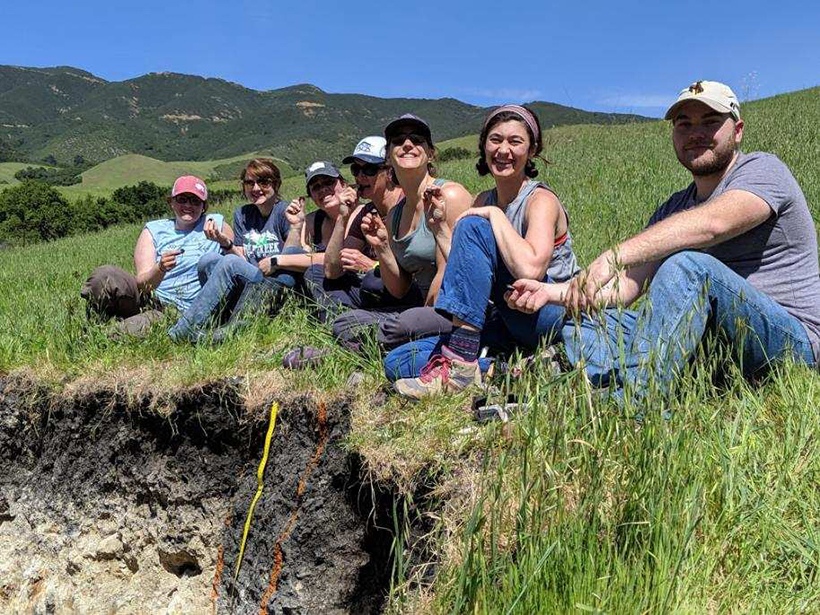On a mild February day in Loveland, Colo., a group of students from Colorado State University (CSU) squatted around a shallow hole dug into the floodplain of the Big Thompson River. Their attention shifted, back and forth, from the moist balls of soil in their hands to the patterned soil texture triangles on the clipboards beside them.
Two months out and the team was focused on the upcoming national soil judging contest.
“The contest allows the students to investigate soil types that they would otherwise not be able to see.”
Formally known as the National Collegiate Soils Contest, this year’s competition ran 14–19 April in San Luis Obispo, Calif., home of California Polytechnic State University (Cal Poly). Sponsored by the American Society of Agronomy, the Soil Science Society of America, and the Natural Resources Conservation Service (NRCS), the National Collegiate Soils Contest has been held every year since 1961.
A record 26 teams from around the country competed this year, including from both CSU and Cal Poly. Although the event is competitive, it is mainly an opportunity for students to broaden their (soil) horizons.
“In the pedology course that I teach, we don’t have the chance to go more than an hour’s drive from campus,” explains Suellen Melzer, an assistant professor of soil and crop science at CSU and one of the team’s cocoaches. “The contest allows the students to investigate soil types that they would otherwise not be able to see.”
The Competition
The national contest is spread across 6 days, with the first 4 allocated for practice and the final 2 for competition. At a minimum, each student probes nearly 20 different soil pits—carved by a backhoe—and gains experience describing soil properties like horizons, texture, color, and structure.
Although each team gets access to the same practice pits, the site of the contest pits is closely guarded.

“The contest location is a big secret,” says Yamina Pressler, a soil ecologist and cocoach of the CSU team who now works as a postdoctoral research associate at Texas A&M University. “Aside from when and where we should meet to leave for the competition, we don’t know anything about the [judging] sites.”
The competitive portion of the event is broken into an individual competition—up to four students from each school can compete—and a team competition in which all students participate and collaborate with their teammates.
Students are judged on how closely their soil descriptions match the descriptions provided by local NRCS professionals and the school coaches, all of whom are soil scientists themselves. At the end of the week, winners are announced for the individual, team, and overall (individual plus team) categories.
2019 Winners
After a week of exploring the California soil and Sun, the University of Maryland emerged as the 2019 overall champion, narrowly edging out Virginia Polytechnic Institute and State University (Virginia Tech). One of Virginia Tech’s students captured the individual title, and the University of Nebraska–Lincoln claimed the team title.
Although everyone wants to win—the University of Maryland students jumped for joy at hearing their names called—the point of the contest is not to crown a champion but to promote soils and provide students with hands-on experience. Because the event is so intensive, soil judging is one of the best ways for students to learn about soils and pedology, says Pressler.
“Far and away, the best part of being involved in soil judging is that it’s an excuse to travel the country and see different soils,” says Gordon Rees, an assistant professor of soil science at Cal Poly and one of this year’s hosts. “The students develop skills that can be applied anywhere but get to do so in a new place.”
And though there are no awards for best soil, one, in particular, stood out.
“The first day in San Luis Obispo, we went to an avocado grove and a lemon grove,” says Pressler. “And then there was one soil that looked like an Oreo cookie. It was awesome.”
—Aaron Sidder (@sidquan), Science Writer
Citation:
Sidder, A. (2019), Making the grade: A week at the national soil judging contest, Eos, 100, https://doi.org/10.1029/2019EO122395. Published on 30 April 2019.
Text © 2019. The authors. CC BY-NC-ND 3.0
Except where otherwise noted, images are subject to copyright. Any reuse without express permission from the copyright owner is prohibited.

